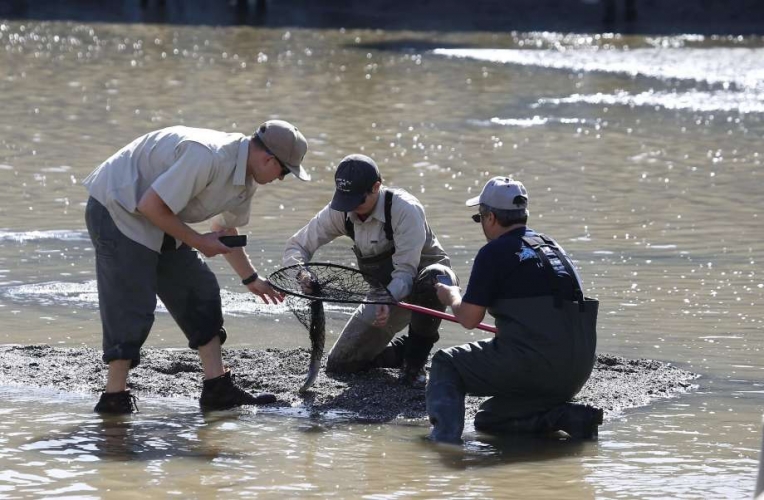
Tracking the trout: East Bay biologists, volunteers give spawning fish a leg up.
Feb 5, 2019 at 4:10am
FREMONT — Over the roar of BART trains speeding along tracks overhead, and the rushing waters of Alameda Creek, it was almost hard to hear the screams of joy let out by a group of people in the waterway when they saw a silvery fish flash along the water line.
It was a sign that the group — a mishmash of fisheries biologists, preservationists and volunteers who waded into the Alameda Creek Flood Control Channel in Fremont Tuesday to catch, tag, and transport steelhead trout upstream — had not come in vain.
“I don’t know if it was a steelhead, it was a sizeable fish,” said Joe Sullivan, the fisheries program director for East Bay Regional Park District, who was waist-high in the channel.
“It skirted up and around our seine,” he said.
For many years, biologists and staffers from the park district, the San Francisco Public Utilities Commission, the nonprofit Alameda Creek Alliance, as well as volunteers, come to this lower creek area every winter when conditions are right for migratory fish spawning.
For decades, the steelhead trout and Chinook salmon trying to complete their instinct-driven trip upstream have been blocked by an impassable concrete structure known as the BART weir, which supports the trains overhead.
When the group catches the fish, both of which are protected under the Endangered Species Act, they can radio tag it to study its migration, and release it upstream where the fish can meet others like it and mate.
“The steelhead have this dramatic, epic lifecycle,” said Jeff Miller, the director of the Alameda Creek Alliance, who was at the creekside.
“They go out, they make this Homeric odyssey around the Pacific. They dodge orcas, they dodge fisherman, they dodge seals and sea lions, then they have to fight their way upstream, against these flows, then we put all these barriers in the way they have to get past,” he said.
“We’re just trying to make it so it’s as accommodating as possible for these migratory fish.”
By midday Tuesday, the group’s haul included just one steelhead trout, but that’s “better than nothing,” Sullivan said.
“It’s just exciting to see them at all come back to the system,” he said. Before 2017, a steelhead hadn’t been spotted in the lower creek since 2008. But for the past three years, they’ve been seen and captured to be relocated.
His hope is that the group will be able to do more captures and relocations this year through March and help boost the trout population upstream.
Within a few years, however, this capturing and relocation may not be necessary as the Alameda County Water District, in conjunction with other public agencies, is investing nearly $70 million in upgrading or replacing rubber dams and building fish ladders and screens to allow the fish to bypass the multiple barriers in the creek.
Fish ladders are essentially a series of pools that step up gradually around a rubber dam or other barrier. The water district has nearly completed a ladder upstream, close to Mission Boulevard. Construction will start this summer on a ladder to get around the BART weir and the rubber dam just beyond it.
Officials said the project will be completed by about spring 2022, after which the trout and salmon should be able to make their way upstream in a more natural fashion.
“It is kind of an interagency, coordinated effort … to ultimately help enhance the population of steelhead,” said Evan Buckland, the water district’s supply supervisor.
Miller said the trout are a good indicator of how healthy the region’s water system is.
“If we can keep the creek clean enough and healthy enough for these fish, we’re doing a good job of taking care of the ecosystem,” he said.
To see the article, click here.
